It’s winter in Maryland. In fact, it’s so much winter I shoveled 10 inches of snow off my driveway this morning. Fortunately, I had company. It wasn’t the kind of company that picks up a shovel and helps out, but still, the American robins darting back and forth over my head were still welcome (if surprising and surprisingly quiet) snow day companions.
Become a Member
Make a lasting impact for nature when you join The Nature Conservancy
“You know,” I said to them as I leaned on my shovel to watch about 25 birds flock together in my neighbor’s oak. “I think y’all are a little early—aren’t you supposed to be the first harbingers of spring?”
We’re not even a month past the first day of winter in the northern hemisphere. Spring is definitely not here. So why are the robins? Shouldn’t they be sunning themselves in warmer climes?
The short answer: as long as there’s food, American robins—true to their name Turdus migratorius (“the wandering thrush”)—kind of spend their winters coming and going as they please.
Robin Migration (AKA Robin Wandering)
Robins do migrate—but they don’t necessarily follow a more or less straight line from north to south in the fall, then repeat the journey south to north in the spring. In the fall and winter, when the ground freezes, robins lose access to their meal of choice: worms, insects (adult and larval) and (occasionally) snails. That’s when they turn to their winter diet staple: mostly fruit, mostly berries.
The folks at Journey North, a project tracking robin movements run by the University of Wisconsin-Madison, put it this way, “Some robins retreat all the way to southern Texas and Florida (in fact, some of the largest winter flocks documented by the Christmas Bird Count gather in sunny St. Petersburg, Florida), but others winter as far north as they can find berries. So they have an enormous winter range. Robins do migrate, but it has more to do with food sources than with being faithful to the same places year over year.”
In that way American robins are somewhat akin to teenage boys—they tend to go where the best (or most abundant or most easily accessible) food is, stay until it’s depleted, and then move on.
So as long as there are enough berries and other fruits to sustain them, you may see robins off and on throughout the winter across much of North America.
Forget the birdseed though. Robins’ digestive systems, unlike sparrows or other so-called feeder birds, aren’t built for dealing with seed, and their beaks aren’t built for cracking things open. Robin beaks are built for snapping up worms, catching insects, and plucking berries and other fruits. In the winter, a flock of robins can strip a holly bush with impressive speed and efficiency, and very little—if any—violent robin-on-robin aggression.
Food is also one of the reasons that robins, notoriously territorial and aggressive in breeding season, tend to gather and travel in flocks in the fall and winter. Numbers are good for defense, and also for spotting food—if one robin happens on a holly tree full of bright, ripe berries, the whole flock can partake. And then move on.
The tendency of robins to flock in winter may also be one of the reasons people seem to notice them—birds in large numbers tend to stand out when they’re gathered in leafless trees. (That and the beautiful red breast that is sometimes the only splash of color in a winter landscape that looks practically lunar in relentless shades of February white and gray.)
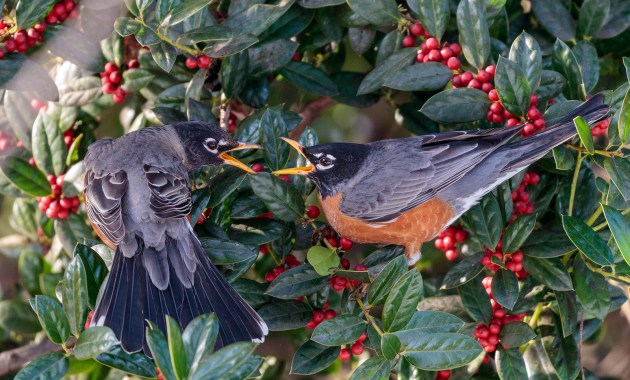
How do Robins Survive the Cold?
Robins are outfitted to survive huge temperature variances. In fact, hot weather seems to stress them more than cold.
If an American robin is healthy, has enough to eat, and is able to main its feathers, the temperature next to its body stays around 104 F—regardless of how cold it is in the world outside. It really is all about those feathers. (And the legs and feet.)
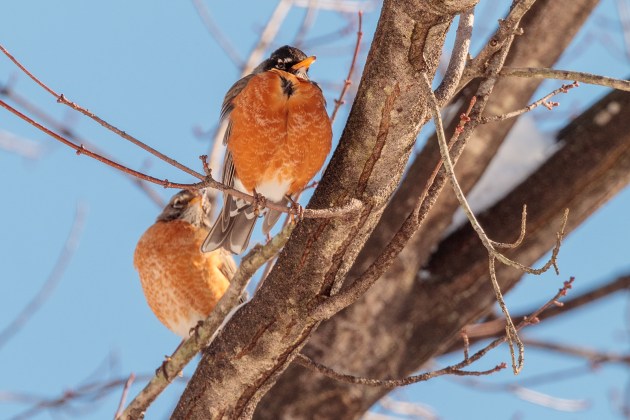
Robins, like most birds, have layers of feathers that perform different functions. When temperatures drop, robins puff the fine, downy feathers closest to their bodies to keep heat in, cold out. The outer feathers act like a kind of overcoat, shedding water and moisture and helping to regulate the bird’s temperature. (It’s an adaptation not limited to robins. Most birds with down feathers fluff them to regulate body heat).
The anatomy of a robin’s (and other bird species) also contributes to their cold adaptations. The bird experts over at the Cornell Lab explain it very well. The simplified version is that “most birds don’t succumb to frostbite because there is so little fluid in the cells of their feet, and their feet are mostly tendons and bones with little muscle or nerve tissue.”
So while blood does flow to their legs and feet, most birds (including robins) benefit from a very fast circulatory system and a “countercurrent heat exchange system.” Because bird legs are thin, the vessels that move blood from the heart to the feet and back again are very close together. That proximity means, per Cornell, “blood flowing back to the body is warmed by blood flowing to the feet. The newly cooled blood in the feet lowers heat loss from the feet, and the warmed blood flowing back into the body prevents the bird from becoming chilled.”
Robins: The Tell-Tale Birds of Spring
If robins are around in winter, why have they always been associated with the beginning of spring in the U.S.? Most likely it has to do with ground thaw, snow melt, and territorial behaviors like singing, worm hunting and nest building. But mostly, it’s the singing.
According to Journey North, which has a fantastic Q+A section I highly recommend for the robin-curious, “the robin’s song remains a reliable indicator that the first wave of spring migration has reached you. This song is one of the first signs that robins are switching from winter behavior to courtship and nesting behaviors associated with spring.”
Robins tend to move north as the ground thaws. The availability of high protein prey, especially worms that emerge with warmer, often wetter weather, is when a robin’s thoughts turn to procreation. And that’s the end of the cooperative fall and winter behaviors.
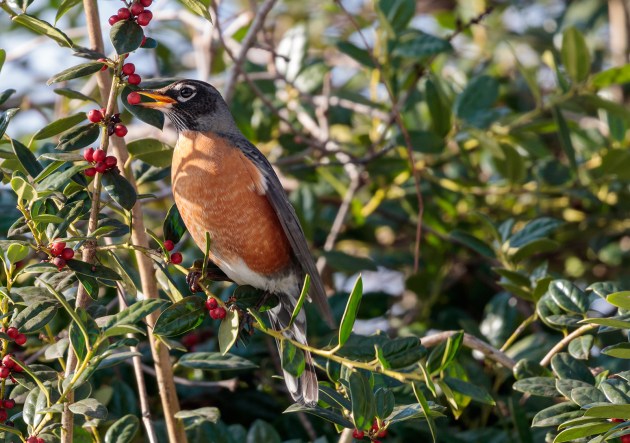
Which is one of the reasons many robins (primarily males) may stay through harsher winters instead of booking it to St. Petersburg: first access to the choicest nesting grounds. Breeding season is when robins also become more visible with mating displays, nest-building and a lot of time on the ground hunting for the tastiest worms. Until then, they’re all about the berries.
You Can Help Robins with Science from Your Own Backyard
Like many species, including other birds, scientists are starting to see some changes in robin behavior that is likely attributable to climate change. One study of American robins migrating to and from Canada’s boreal forest, showed that they’re beginning to journey south on average about 12 days earlier than in past years, or five days earlier per decade since 1994.
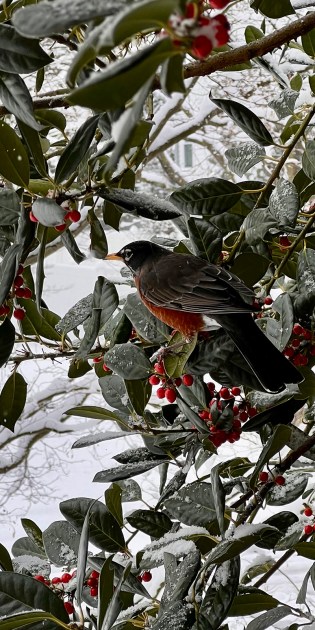
If you want to help scientists studying birds, there are several ways to contribute your observations (not just for robins, but for many of the species you can see outside your windows).
Journey North
You can submit your robin observations directly on the Journey North site (and check out their other migration-related citizen science projects). They also have 2025 maps tracking sightings so you can see where American robins (and other signs of spring) are being observed and follow along (and contribute to) the wanderings of Turdus migratorius.
Cornell Lab of Ornithology
The Cornell Lab has a number of different ways you can contribute to science for birds. Your sightings tracked on eBird (free) contribute to worldwide data for birding, science, and conservation. Want to know what birds are being seen in your neighborhood, eBird has a feature for that. If you’re new to birding, check out their genius birding ID app, Merlin.
You can also contribute to Project FeederWatch (requires subscription) by counting birds at your feeder from November through April. Your observations help scientists monitor changes in the abundance and distribution of birds, including the influence of changes in habitat, disease, and climate.
And mark your calendars for the 2025 Great Backyard Bird Count (February 14-17). Spend time in your favorite places watching birds—then report them to Cornell! It’s easy to participate, “in as little as 15 minutes notice the birds around you. Identify them, count them, and submit your counts to help scientists better understand and protect birds around the world. You can see the results from 2024 here.
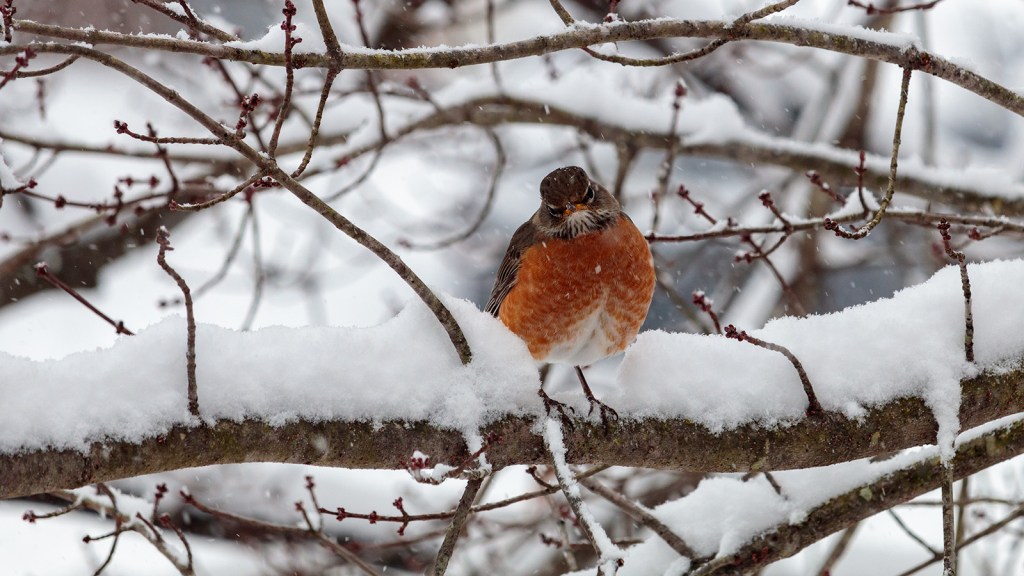



It’s January 2nd, after two days of rain, our yard is saturated and muddy. This morning there were at least a dozen male robins searching for worms in the mud. When I left the house, I saw an accumulation of nesting material strewn beneath their favorite nesting local under the eaves on my front porch.
IT IS THE last week of December and has be very warm but robins and swarms of black birds are just every warm and winter has just started. I KNOW ROBINS never go south but deep in to the woods and some abandoned bldgs. They left last summer the first week in august and do know they do not like people, but think our warm weather is fooling them for this time of the tear and winter has just started.
Robin frequently on my feeder for the past few days,it must be far too early for breeding. They bred early last year ,but not as early as this,also bought 4 babies back to our garden to be fed,then they fed themselves,and stayed for several weeks.
We have lived in the same house in Toronto, Canada for 34 years. In the spring, I have always seen a lone Robin looking for worms. A year ago, during the pandemic, I saw 2 spring Robins
Yesterday, Christmas Day we observed 5 Robins in our backyard tree. Our neighbors have a cherry tree and maybe that was the attraction. It was a mild 7 celsius degree day.
Your blog explains exactly why this unusual sighting may have occured.
Thanks for explaining so clearly.
I love the picture of the juvenile robin. I will keep my eye out for them.
Thank you so much for the info. It explains why we are seeing flocks of robins using the bird baths and eating apples and berries from the urban landscape.
A nice surprise at Christmas time.
I live in Montreal, Canada where we now have snow on the ground and it’s getting quite cold. Yesterday, December 24th, 2021 I was doing some last minute Christmas shopping and I couldn’t believe my eyes. I saw two robins on the ground and another in a tree. The temperature was around -4 celsius which in farenheit would be about 24 degrees. I was so excited to see them as they are one of my favourite birds, but at the same time I was worried for them. It’s the first time I’ve seen robins in this temperature. I have seen robins in January when we’ve had an exceptionally mild winter (which isn’t that often). I’m glad I came across this article. I feel much better now, knowing they’ll be okay.
I was walking thru the park this morning and to my surprise I saw a flock of male robins feeding. WOW!! I have never seen robins in the winter. I had done some research and learned that some robins do winter over. I was so excited to see the flock of males. I live in Malden MA.
Today, 12/15/21, we had probably thousands of robins in our yard, eating berries and worms and singing for several hours while it rained heavily. We’re in Willits, CA, Mendocino County, Brooktrails. This was a wonderful first time nomadic flock sighting. They were singing spring-like songs. We’ve lived here almost 60 years.
Lisa,
We rescued a baby robin off the ground in an ice storm this spring that has been returning almost daily of late (Nov 21). She (?) was hand fed with foods we purchased since the ground was completely devoid of worms and bugs due to extreme dryness and exacerbated by local forest fires. She had been associating with wild robins but now is solitary since the others have moved on. I am worried that she may not have enough wild skills having been separated from her parents to survive our frigid winter. Am I being overly concerned? She seems to be finding food somewhere but wonder about later when snow covers everything. I hope you can allay my fears for her.
Thank you
We were delighted with a robin’s nest appearing just outside our window on our NYC fire escape, witnessing two hatchlings get raised in early Spring. The nest was amazingly resilient holding shape through hurricanes and nor’easters. Then in late October, the robins returned and have been dismantling the nest, picking out strands and flying off with them, it is half-gone. What could be a motivation for this?
I’ve seen large flocks of Robins lately are they getting ready to fly South? I read your column. But didn’t see any last winter.
10/30/2021
Findlay, OH
We had a day this week of a gentle all day rain. There was water flowing out of the downspout and making a medium size puddle in the dirt. My daughter notice several robins using the puddle like a hot tub, taking turns frolicing in it, drinking and fighting for space, thoroughly enjoying this new water source. What surprised us is they enjoyed this dirt puddle over the two bird baths we have out with clean water in them! It was a small flock of not more than ten bathing, and eating the abundant earthworms the rain had brought to the surface. We hadn’t seen this many at one time all summer. We think they must have been traveling through on their way south and stopped for dinner and a bath. Glad we could oblige!
10/23/21 suburbs of Chicago. I have fruit trees in my yard and I see many male robins with the redish breast. Where are the females? Have they migrated already?
Hello, I live in Sherwood Park, Alberta Canada. Thought I heard our first Robin Mid-March but nothing since then. We have always had Robins in our neighbourhood.My Dad in a small town north east of us, Smoky Lake, watches and feeds his birds notices the lack of Robins. Love and truly miss their beautiful spring song.
Has something happened to the Robin population 2021 to mark such a drastic decrease in their population. Can you help us explain where did the Robins go??
The flock arrived today. The 25 foot mountain ash will be stripped in two days. This repeats every year. Thanks for the blog explaining this phenomenon. Gary in Blackfoot,Idaho.